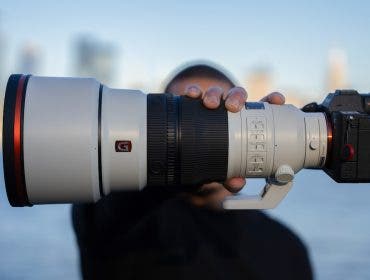The Sony Alpha α9 III is the world’s first full-frame mirrorless camera with Global Shutter. It introduces many revolutionary new technologies that significantly benefit professional photographers and filmmakers. Sony A9 III’s Global Shutter is a game changer for flash photography. However, before we delve into the significant advantages of the a9 III’s global shutter for shooting with flash, let’s review some of the additional new features announced with the a9 III.
Notable Features:
- Blackout-free, 120 fps continuous burst shooting, with full AF/AE tracking
- Maximum shutter speed of 1/80,000th of a second
- Composite RAW shooting for noise reduction
- Advanced optical 5-axis in-body image stabilization
- Up to 1 second of Pre-Capture shooting
- Continuous shooting speed boost
- Real-time subject recognition AF with human pose estimation AI
- Customizable focus areas
- Flash sync at up to 1/80,000th of a second shutter speed without needing High-Speed Sync
- Flicker-free shooting eliminates artifacts from artificial lighting
- Elimination of flash banding artifacts with Global Shutter
- 4K 120p without cropping for the first time in any Alpha camera
- Focus Breathing compensation
- Dynamic Active Image Stabilization
- New ergonomic grip design
- UVC/UAC support for high-quality webcam applications
- USB PD (Power Delivery) supports fast charging
Global Shutter Changes the Game for Flash Photography

In order to understand why the a9 III’s global shutter is such a game changer for flash photography, it’s essential that we first consider how it differs from traditional “Rolling Shutter” imaging sensors that we’ve been shooting with until now.
Rolling shutter cameras capture images by exposing the sensor line-by-line from the top to the bottom, using a mechanical shutter mechanism that opens and closes with each actuation of the shutter button. This coordination between the mechanical shutter’s actuation process and the line-by-line sensor read-out results in different parts of your image being exposed to light at different times throughout the exposure process.
One of the key limiting factors of rolling shutter cameras is what’s called sensor “read-out speed,” which is generally referred to as the speed at which a rolling shutter sensor can read out the sequential lines of exposure data. If the camera takes too long to read the imaging data from the sensor, and the physical movement of the subject is faster than the read-out of the data, you will usually experience a plethora of rolling shutter imaging artifacts, including things like distortions, warped lines, uneven lighting, and flash banding.
How the Global Shutter Works
Sony’s a9 III completely eliminates all of the drawbacks of rolling shutter sensors, thanks to its revolutionary global shutter. This technology is completely electronic, with no physical, mechanical shutter mechanism and no need to read sequential imaging data line-by-line since it captures every sensor pixel simultaneously. Global shutter removes all of the limitations of mechanical shutter mechanisms, including all rolling shutter artifacts, and all of the limitations of having a flash “Shutter Sync Speed,” giving photographers the ability to sync flash at any shutter speed, all the way up to an incredible 1/80,000th of a second.

The key takeaway to keep in mind is that a9 IIII’s Global Shutter now gives us access to more control of ambient light and flash power than ever before, while also eliminating all of the imaging artifacts and sync speed limitations of rolling shutter sensors.
Maximizing Flash Power With Flash Timing Settings
Combining the power of a9 III’s Global Shutter with flash can greatly improve the exposure, color, and overall quality of your photos. I love the look and versatility that I get when shooting with high-quality strobes, which is why I’ve personally been using Flashpoint lighting for almost a decade.
I most recently took my XPLOR 300 Pro to Thailand with my a9 III and used it for all of my OCF portrait photography. It gave me lots of power and was compact and easy to travel with, especially when paired with my Flashpoint R2 Nano trigger.
One additional thing to remember when using third-party lighting options with the Sony a9 III is the need to adjust the camera’s “Flash Timing Setting”. This is a setting that gives a delay for the coordination of a9 III’s blazing-fast Global Shutter, and the wireless trigger transmission signal that needs to reach your flash.
With a compatible Sony flash unit, such as the HVL-F60RM2 or the HVL-F46RM, the a9 III can perform full flash synchronization up to its maximum 1/80,000th of a second shutter speed at full flash power without the need to use High-Speed Sync or adjust your flash timing settings.
Simple Adjustment is All That is Needed
My XPLOR 300 Pro functions exactly the same way, however, with the exception that it requires a simple manual adjustment to the flash timing setting for the trigger delay so that a9 III’s incredibly fast Global Shutter can synchronize the exposure to the trigger timing of my flash.
It’s really easy to adjust the Flash Timing Setting with the a9 III. Sony recommends that adjustments be made in 20-microsecond increments to find the ideal trigger timing and flash output. While on location in Thailand, I simply chose my ambient exposure and then adjusted my flash timing setting incrementally until I found the ideal light output from my flash.
The good news is that whether you choose to use Sony native flash units or Flashpoint Lighting, the Global Shutter on a9 III allows your flash to use less power, be more efficient, recycle faster, and even get more output than any Rolling Shutter camera, all while using smaller lights.

No More Flash Banding
Another significant benefit of shooting flash with a9 III’s Global Shutter is the elimination of a common artifact with rolling shutter cameras, known as “Flash Banding.” When using flash in a group with other photographers, all of the simultaneous flashes can interfere with your exposures and cause light banding at the top and bottom of your images. This type of flash banding is common in rolling shutter cameras and is caused by the sensor read-out speed issue that we covered earlier in this article.
The elimination of flash banding is an essential benefit of the Global Shutter image sensor in the a9 III, which allows it to expose and read out all of the pixels on the imaging sensor at the same time. It eliminates any exposure differences that can occur from slow read-out speeds and mechanical shutters, enabling a much higher success rate when shooting flash photography, even in situations where multiple photographers are covering an event and shooting flash at the same time.

Conclusion
The Sony a9 III is the ideal camera for flash photography. It’s ideal for traveling with smaller lights, since it offers better control of ambient light with its 1/80,000th of a second sync speed, and eliminates the need for HSS and rolling shutter distortions. In my opinion, there is no better camera for shooting flash photography than the Sony a9 III, especially with its revolutionary Global Shutter technology. It reduces the need for large and heavy lighting setups and greatly expands your lighting capabilities.






